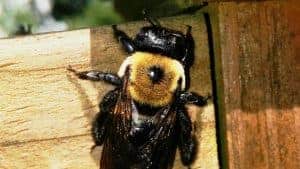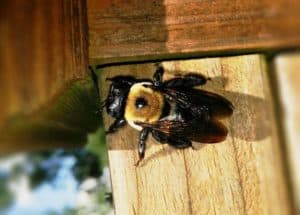How Can I Get Rid of Carpenter Bees or Wood Bees?
Carpenter bees, also called wood bees, are everywhere right now, buzzing around everyone’s head and drilling holes in any exposed wood they can find.
Since carpenter bees prefer bare wood, painting and staining wood can sometimes deter them. However, we have also seen many instances where painted and stained wood were attacked. 
To deter wood boring bees and prevent them from entering or damaging your home, seal cracks and crevices along the property’s foundation and walls with a silicone-based caulk, repair any tears in screens, and keep doors closed at all times. Preventative treatments can also be effective to help reduce carpenter bee activity and damage to structures.
Need some help with wood or carpenter bees?
DIY Solutions for Carpenter Bees
If you prefer a DIY approach, you can try one of the following methods to help prevent carpenter bee damage to your property:
- Paint all unfinished wood. Wood bees prefer bare wood. However, we have seen carpenter bee damage in painted wood, but if you like painting, it can be worth a try.
- Encase your bare wood with vinyl or aluminum. This can be a significant project, but it provides a long-term solution. This is often done on the wood around windows and wooden trim.
- At night, spray a bee specific insecticide. Be sure to wear protective clothing since the bees will likely try to come out while you are spraying. Don’t forget to wear a respirator so you don’t inhale the airborne insecticide.
- You can make a game of it and try swatting them with a racquetball racket. While entertaining, it doesn’t do much to reduce the population. The few that you might hit are a very small percentage of the population.
Can Wood Bees Cause Substantial Damage?
While carpenter bees may seem like nothing more than a nuisance, their damage can literally collapse a structure.
 Carpenter bees get their name from their habit of boring into wood. They do not eat wood, their damage comes from drilling holes with their mouth to create tunnels inside the wood. The holes really do look like they were made with a ½-inch drill bit. These tunnels vary in length, with the most common tunnel lengths ranging from 4” to 6” in the first year.
Carpenter bees get their name from their habit of boring into wood. They do not eat wood, their damage comes from drilling holes with their mouth to create tunnels inside the wood. The holes really do look like they were made with a ½-inch drill bit. These tunnels vary in length, with the most common tunnel lengths ranging from 4” to 6” in the first year.
This may not sound like much damage but, year-after-year, the off-spring will continue to expand the tunnels which have been known to extend 10 feet or more with many branches off of the main tunnel. Over time, the volume of tunnels in a board can be incredible and contribute to structural instability and significant damage.
To identify early damage to buildings, homeowners should regularly inspect the perimeter of the home and surrounding property for the presence of these holes and hovering bees. Sometimes you can also see the small piles of sawdust below where they have been drilling.
Carpenter bees are a serious property threat and cause structural damage over time if left unchecked – especially if they repeatedly bore holes for nesting throughout the building. Furthermore, the large carpenter bee larvae are attractive to woodpeckers that seek out developing carpenter bees and create more extensive damage to the existing holes. Woodpeckers will peck and tear out the existing holes to access the larvae.
How do I Kill a Carpenter Bee Nest?
Unlike more common bees and wasps that live in nests, carpenter bees are not social insects. This is one of their unique traits that makes them difficult to exterminate.
Carpenter bees build individual nests into trees or into the frames, eaves, or sides of structures. Once they emerge in the spring, male bees become extremely territorial. Male bees do not sting. Female bees can sting, but rarely do. After emerging, female bees will lay eggs inside the tunnel nests. Once the eggs hatch, the larvae will mature in about 36 days. Adult bees overwinter in abandoned tunnels, using stored pollen to subsist until the following spring.
If you see carpenter bee activity in and around your home or structure, have a bee and wasp removal professional inspect and treat any activity immediately.

Lawn Care
Green Giant Home & Commercial’s Lawn Care services control weeds, build the thickness and density of your lawn and protect it from being damaged by insects and disease, providing you with a great-looking, healthy lawn. We offer fertilization, weed control, liming, insect control, and aeration and overseeding. Visit our Lawn Care page for more information.
Tree Care
Green Giant performs: Proper Diagnosis and Treatment of Tree & Shrub Problems, Insect & Disease Control (including Spotted Lanternfly), and Nutrient Management via Deep Root Fertilization to keep your plants healthy and thriving. Visit our Tree Care page for more information.
Vegetation Management
Green Giant’s Non-Lawn Weed Control services eliminate unwanted vegetation in a wide variety of locations for both residential and large commercial/municipal properties. Areas include fence lines, around obstacles to reduce weed eating, stone/gravel driveways & parking lots, swales, roadside/curbside vegetation management and more. Find more information, visit our Vegetation Management page.
Pest Control
Our full service pest control division provides both Year-Round Service Programs that cover the vast majority of pests that you will encounter and also One-Time Corrective Services for pests such as bees, ants, termites or mice. For more information, visit our Pest Control page.